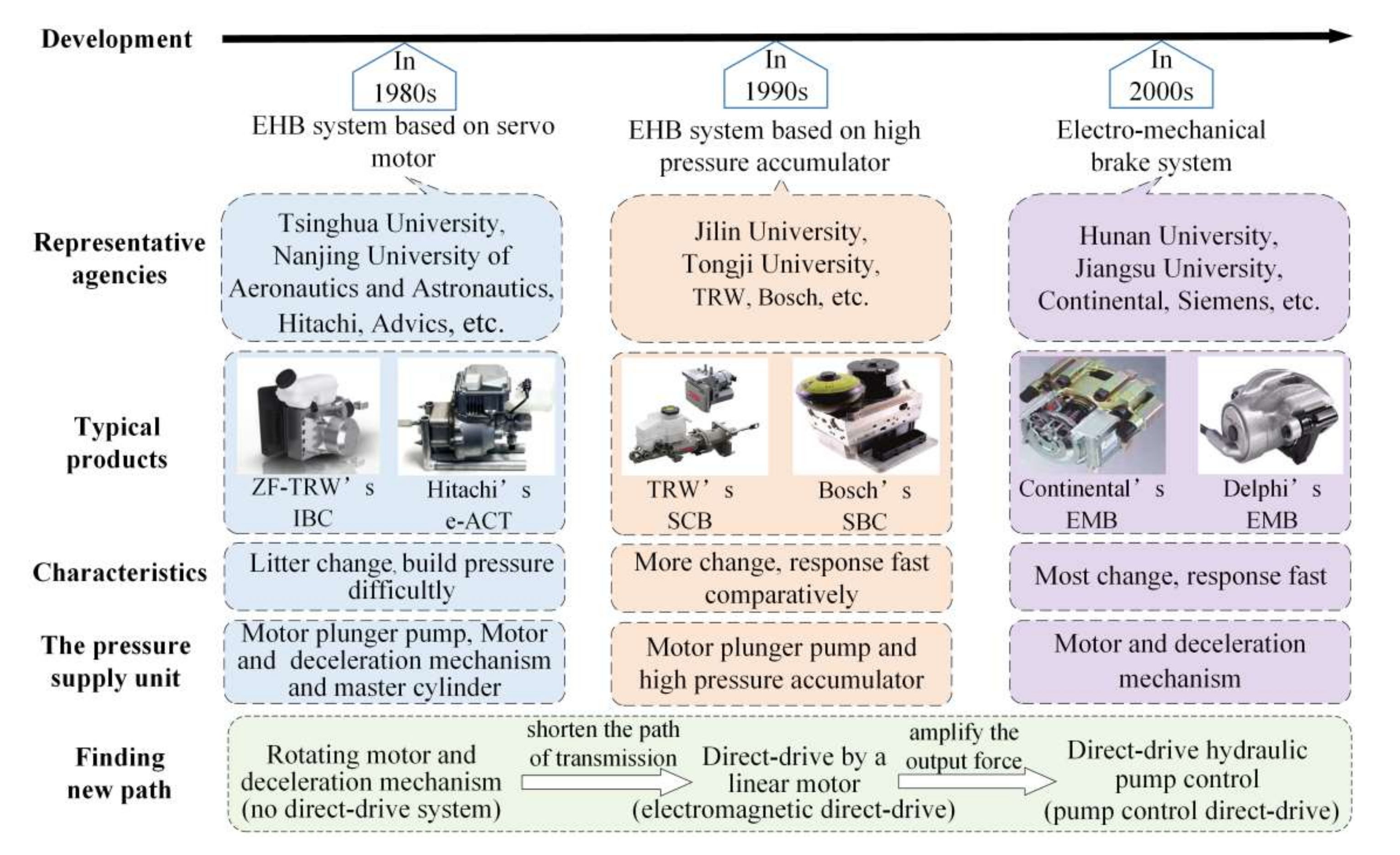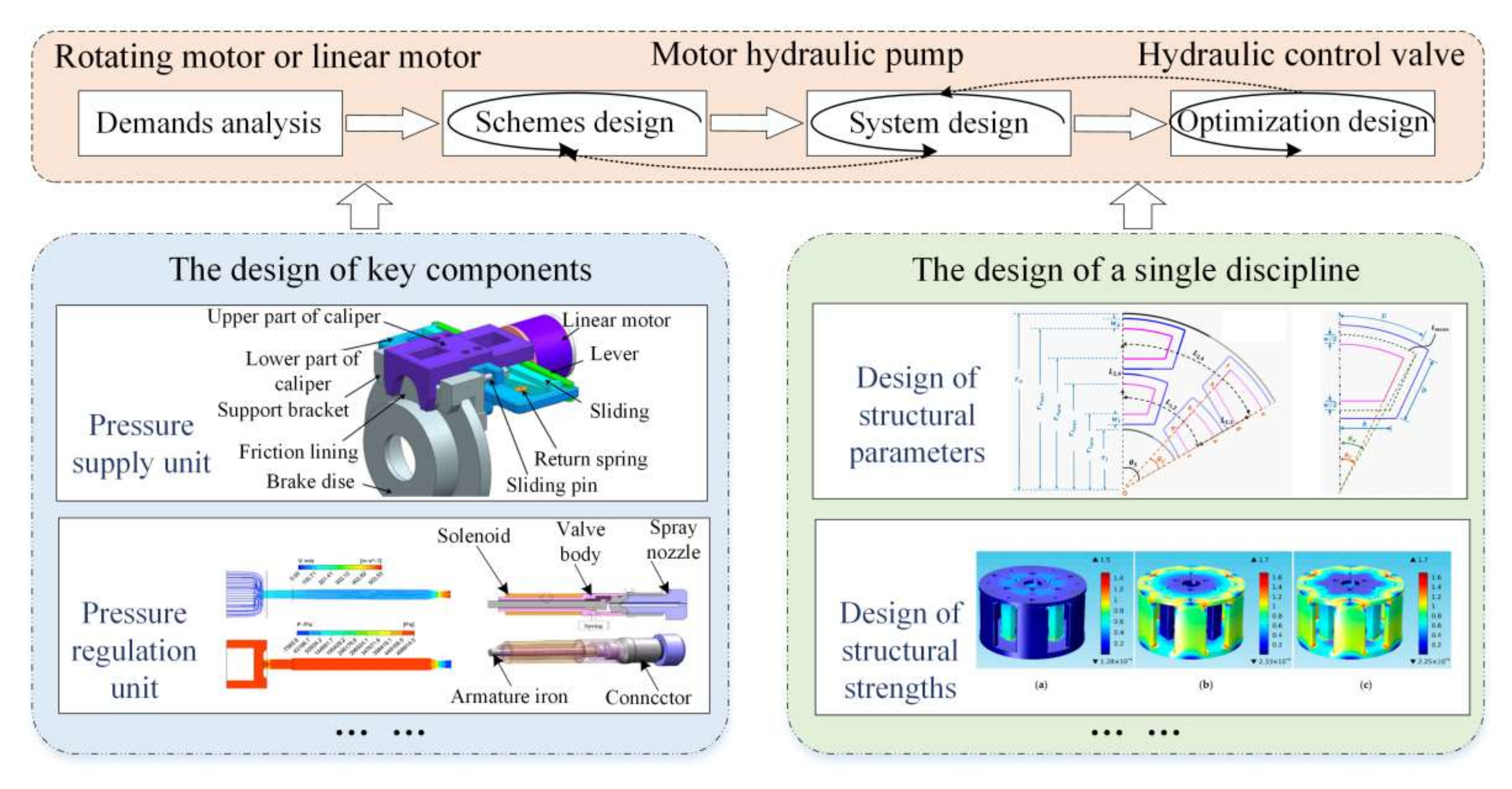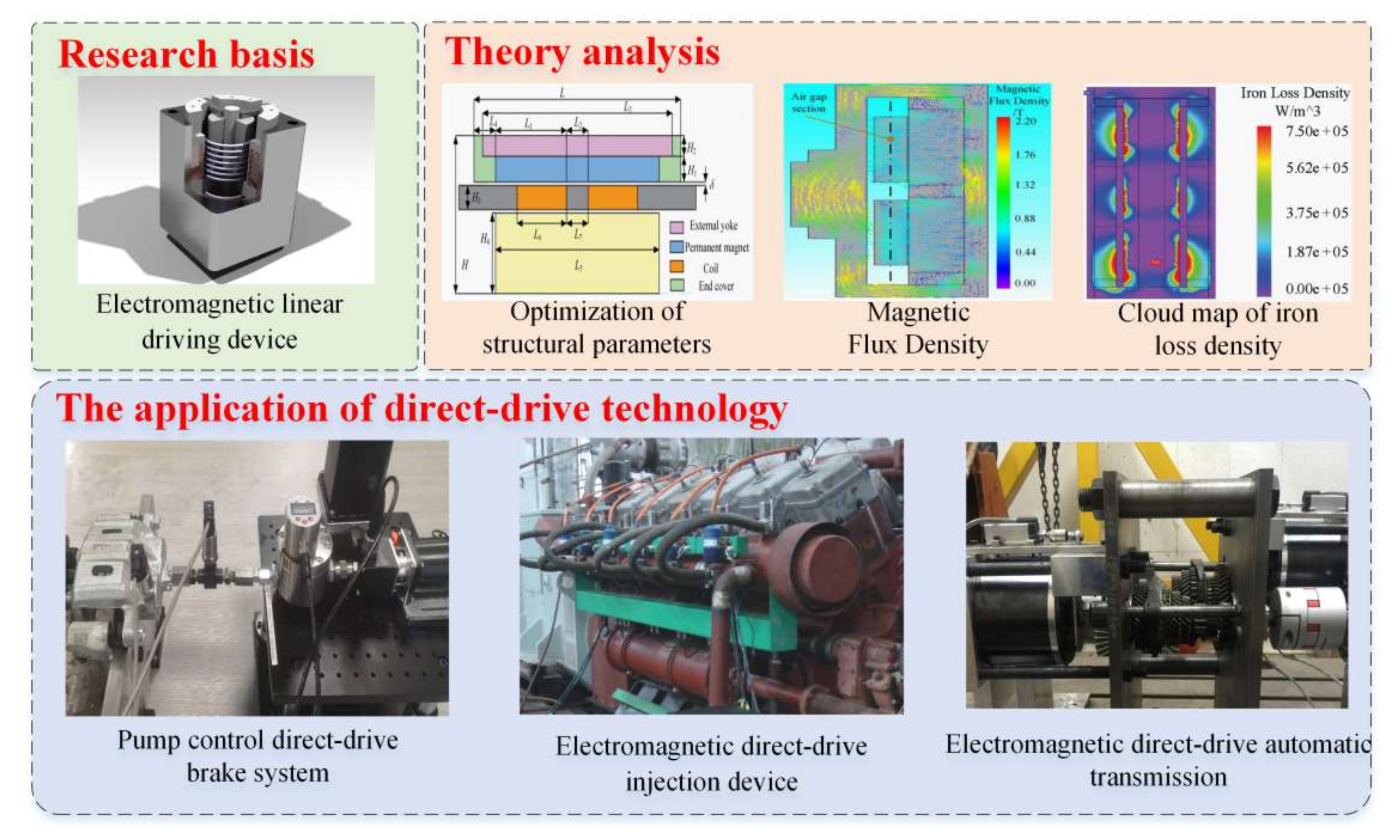Review of Brake-by-Wire System and Control Technology
Abstract
1. Introduction
2. Structures of BBW System
2.1. Electro-Hydraulic Brake System Based on Servo Motor
2.2. Electro-Hydraulic Brake System Based on High-Pressure Accumulator
2.3. Electro-Mechanical Brake System
3. Design Flow of the BBW System
3.1. The Design of Key Components
3.1.1. The Pressure Supply Unit
3.1.2. The Pressure Regulation Unit
3.2. The Design of Single Discipline
4. Lower Control Technology of BBW System
4.1. The Method of Modeling
4.2. The Method of Control
5. Upper Coordination Strategy of BBW System
5.1. The Control Strategy of Anti-Lock Brake System
5.2. The Control Strategy of Braking Force Distribution
5.3. The Control Strategy of Regenerative Braking
5.4. The Control Strategy of Intelligent Coordination
6. Fault-Tolerant Control Technology of BBW System
6.1. The Method of Fault Diagnosis
6.2. The Method of Fault-Tolerant Control
7. A Trend of BBW System
8. Conclusions
Author Contributions
Funding
Institutional Review Board Statement
Informed Consent Statement
Data Availability Statement
Conflicts of Interest
References
- Zong, C.; Li, G.; Zheng, H.; He, L.; Zhang, Z. Study process and outlook of chassis control technology for X-by-wire automobile. China J. Highw. Transp. 2013, 26, 160–176. [Google Scholar]
- Zhao, X.; Ye, Y.; Ma, J.; Shi, P.; Chen, H. Construction of electric vehicle driving cycle for studying electric vehicle energy consumption and equivalent emissions. Environ. Sci. Pollut. Res. 2020, 27, 37395–37409. [Google Scholar] [CrossRef] [PubMed]
- Kumar, R.; Alok, K. Adoption of electric vehicle: A literature review and prospects for sustainability. J. Clean. Prod. 2020, 253, 119911. [Google Scholar] [CrossRef]
- Yu, Z.; Han, W.; Xu, S.; Xiong, L. Review on hydraulic pressure control of electro-hydraulic brake system. J. Mech. Eng. 2017, 53, 1–15. [Google Scholar] [CrossRef]
- Editorial Department of China Journal of Highway and Transport. Review on China’s automotive engineering research progress: 2017. China J. Highw. Transp. 2017, 30, 1–197. [Google Scholar]
- Chen, H.; Gong, X.; Hu, Y.; Liu, Q.; Gao, B.; Guo, H. Automotive control: The state of the art and perspective. Acta Autom. Sin. 2013, 39, 322–346. [Google Scholar] [CrossRef]
- Zhang, J.; Lv, C.; Li, Y. Hybrid propulsion and hybrid braking technologies of electrified vehicles: Status and prospect. J. Automot. Saf. Energy 2014, 5, 209–223. [Google Scholar]
- Li, L.; Wang, X.; Cheng, S.; Chen, X.; Huang, C.; Ping, X.; Wei, L. Technologies of control-by-wire and drnamic domain control for automotive chassis. J. Automot. Saf. Energy 2020, 11, 143–160. [Google Scholar]
- Gong, X.; Ge, W.; Yan, J.; Zhang, Y.; Gongye, X. Review on the development, control method and application prospect of brake-by-wire actuator. Actuators 2020, 9, 15. [Google Scholar] [CrossRef]
- Meng, B.; Yang, F.; Liu, J.; Wang, Y. A survey of brake-by-wire system for intelligent connected electric vehicles. IEEE Access 2020, 8, 225424–225436. [Google Scholar] [CrossRef]
- He, R.; Feng, H. Research and development of autonomous emergency brake (AEB) technology. J. Automot. Saf. Energy 2019, 10, 1. [Google Scholar]
- Braking Control Systems: Integrated Brake Control (IBC). Available online: https://www.zf.com/products/en/cars/products_%20316%2080.html (accessed on 13 March 2019).
- Ohtani, Y.; Innami, T.; Obata, T.; Yamaguchi, T. Development of an electrically-driven intelligent brake unit. SAE Tech. Pap. Ser. 2011, 1, 572. [Google Scholar]
- Savitski, D.; Ivanov, V.; Schleinin, D.; Augsburg, K.; Putz, T.; Lee, C. Advanced control functions of decoupled electro-hydraulic brake system. In Proceedings of the IEEE 14th International Workshop on Advanced Motion Control (AMC), Auckland, New Zealand, 22–24 April 2016; pp. 310–317. [Google Scholar]
- Nakata, D.; Okano, T.; Fukasawa, T. Brake Apparatus Brake Control Unit and Brake Control Method. U.S. Patent 8303046B2, 6 August 2012. [Google Scholar]
- Jungbecker, J.; Schmitt, S.; Hoffmann, O. Actuating Unit for An Electromechanically Actuated Disc Brake. U.S. Patent 6752249B1, 17 February 2004. [Google Scholar]
- Lvarez, B.; Longuemare, P.; Heck, T.W. Electromechanical Brake and Method for Controlling Same. EUR. Patent 1456555B1, 27 February 2001. [Google Scholar]
- Wang, L. MK C1: Braking made simple. Automot. Obs. 2019, 6, 106–107. [Google Scholar]
- Fujiki, N.; Koike, Y.; Ito, Y.; Suzuki, G.; Gotoh, S.; Ohtani, Y.; Yamagucki, T. Development of an electrically-driven intelligent brake system for EV. SAE Tech. Pap. Ser. 2011, 4, 399–405. [Google Scholar]
- Wang, W. Dynamics Analysis on Electronic Stability Control system Hydraulic Control Unit and Establishing an Integrated Simulation Platform; Tsinghua University: Beijing, China, 2011. [Google Scholar]
- Yu, Z.; Huang, J.; Jian, C.; Xiong, L. An electronic Hydraulic Brake System Driven by a Motor. CN Patent 204567652, 19 August 2015. [Google Scholar]
- He, R.; Wu, J.; Gao, J. Modeling and compensation control for friction in vehicle power assisted braking system. Automot. Eng. 2017, 39, 683–688. [Google Scholar]
- Nakamura, E.; Soga, M.; Sakai, A.; Otomo, A.; Kobayashi, T. Development of electronically controlled brake system for hybrid vehicle. SAE Tech. Pap. Ser. 2002, 1, 300. [Google Scholar]
- Cai, B. Structural principle analysis of SBC braking system on benz. Auto Electric Parts 2012, 9, 13–16. [Google Scholar]
- Zhang, H. Analyse and Control of Electro Hydraulic Braking System for Vehicle; Nanjing University of Aeronautics and Astronautics: Nanjing, China, 2013. [Google Scholar]
- Keller, F. Electromagnetic Wheel Brake Device. U.S. Patent 6536561, 25 January 2003. [Google Scholar]
- Rieth, P.; Schwarz, R.; Kranlich, H. Actuating Unit for an Electromechanically Operable Disc Brake. U.S. Patent 6405836, 24 June 2002. [Google Scholar]
- Lin, Z. Siemens VDO electronic wedge brake. Shanghai Auto 2007, 5, 38–40. [Google Scholar]
- Song, J.; Wang, H.; Liu, G. The Electro-Mechanical Brake of Connecting Rod. CN Patent 2895873Y, 4 December 2007. [Google Scholar]
- Shen, C.; Wang, J.; Lin, Y. Study on brake actuator of electro-mechanical braking System. Trans. Chin. Soc. Agric. Mach. 2007, 38, 30–33. [Google Scholar]
- Li, J.; Yang, K.; Tan, S. The Electro-Mechanical Brake Actuator of Using in Vehicle. CN Patent 201212535Y, 15 November 2009. [Google Scholar]
- Xiao, F.; Gong, X.; Lu, Z.; Qian, L.; Zhang, Y.; Wang, L. Design and control of new brake-by-wire actuator for vehicle based on linear motor and lever mechanism. IEEE Access 2021, 9, 95832–95842. [Google Scholar] [CrossRef]
- Liao, Z.; Bai, X.; Li, Y.; Deng, X.; Sun, J. Design, modeling, and verification of a test bench for braking simulation of 1/4 vehicle. Proc. Inst. Mech. Eng. Part D J. Automob. Eng. 2020, 234, 1425–1441. [Google Scholar] [CrossRef]
- Zhuo, Z.; Li, Z. Design and simulation of a micro thrust solenoid valve nozzle based on CFD&DOE optimization analysis. J. Phys. Conf. Ser. 2021, 1786, 12008. [Google Scholar]
- Iqbal, H.; Yi, B. Design of a new bilayer multipole electromagnetic brake system for a haptic interface. Appl. Sci. 2019, 9, 5394. [Google Scholar] [CrossRef]
- Ki, Y.; Lee, K.; Cheon, J.; Ahn, H. Design and implementation of a new clamping force estimator in electro-mechanical brake systems. Int. J. Automot. Technol. 2013, 14, 739–745. [Google Scholar] [CrossRef]
- Han, K.; Kim, M.; Huh, K. Modeling and control of an electronic wedge brake. Proc. Inst. Mech. Eng. Part. C J. Mech. Eng. Sci. 2012, 226, 2440–2455. [Google Scholar] [CrossRef]
- Shangguan, W.; Liang, T.; Jiang, K.; Tang, W. Modeling and pressure control of integrated electro-hydraulic brake system. J. Beijing Inst. Technol. 2019, 39, 413–418. [Google Scholar]
- Mai, L.; Zhang, J.; Zong, C.; Zheng, H.; Guo, L. Vehicle stability control based on electronic hydraulic brake system. J. Jilin Univ. Eng. Technol. Ed. 2010, 40, 607–613. [Google Scholar]
- Gong, X.; Chang, S.; Jiang, L.; Li, X. A novel brake-by-wire unit and control system for electric vehicle. J. Shanghai Jiao Tong Univ. 2016, 50, 395–400. [Google Scholar]
- Li, Y.; Jin, Z.; Wang, X.; Zhang, X. Dynamic analysis and control of the wire-controlled hydraulic braking system for heavy vehicles. J. Dyn. Control 2021, 19, 15–21. [Google Scholar]
- Li, B.; Li, D.; Ge, W.; Tan, C.; Lu, J.; Song, A. Precision control of hydraulic pressure in fast-response brake-by-wire system based on direct-drive valve. China J. Highw. Transp. 2021, 34, 121–132. [Google Scholar]
- Chu, L.; Wang, Y.; Qi, F.; Zhang, Y. Control method of inlet vales for brake pressure fine regulation. J. Jilin Univ. Eng. Technol. Ed. 2013, 43, 564–570. [Google Scholar]
- Xiong, L.; Han, W.; Yu, Z.; Li, H. Pressure precisely control of master cylinder on integrated-electrohydraulic brake system considering the critical nonlinear. J. Mech. Eng. 2019, 55, 117–126. [Google Scholar]
- Yao, Y. Simulation and Experiment Research on Electro-Hydraulic Brake System; Wuhan University of Technology: Wuhan, China, 2014. [Google Scholar]
- Wang, X.; Wu, X.; Cheng, S.; Shi, J.; Ping, X.; Yue, W. Design and experiment of control architecture and adaptive dual-loop controller for brake-by-wire system with an electric booster. IEEE Trans. Transp. Electrif. 2020, 6, 1236–1252. [Google Scholar] [CrossRef]
- Li, J.; Ding, M.; Huang, J.; Huang, Z. Evaluation and optimization of the nonlinear flow controllability of on-off solenoid valve. J. Jilin Univ. Eng. Technol. Ed. 2019, 49, 325–335. [Google Scholar]
- Hu, D.; He, R.; Xu, X.; Yi, F. Analysis on influencing factors of energy consumption characteristics of electronic hydraulic braking system. J. Beijing Inst. Technol. 2018, 38, 261–266. [Google Scholar]
- Xia, L.; Deng, Z. Calculation and analysis of friction torque and energy dissipation of electromechanical brake actuator. J. Hunan Univ. 2018, 45, 48–56. [Google Scholar]
- Zhao, X.; Yu, Q.; Yuan, X.; Shi, P. A research on the brake temperature rise model of heavy truck running on long downhill. Automot. Eng. 2015, 37, 472–475. [Google Scholar]
- Jin, Y.; Pan, D.; Sun, Z.; Zou, Z.; Li, L. Multi-physics simulation analysis of axial permanent magnet eddy current brake. Proc. CSEE 2020, 40, 7469–7480. [Google Scholar]
- Lin, H.; Zhuo, G. Electro-hydraulic brake system model identification. J. Jilin Univ. Eng. Technol. Ed. 2011, 41, 70–73. [Google Scholar]
- Meng, F.; Tao, G.; Wang, B.; Tao, J.; Chen, H. Identification and control of friction parameters and dead zone parameters of pneumatic servo system. J. Cent. South. Univ. Nat. Sci. Ed. 2018, 49, 2700–2708. [Google Scholar]
- Zhang, J.; Li, J. Parameter identification of automotive ESP hydraulic system based on genetic algorithm. Trans. Chin. Soc. Agric. Mach. 2015, 46, 308–313. [Google Scholar]
- Jin, Z.; Guo, L.; Shi, R.; Zhao, Y.; Shi, Z. Experimental study on dynamic characteristics of electro hydraulic brake system for vehicle. J. Mech. Eng. 2012, 48, 127–132. [Google Scholar] [CrossRef]
- Ma, R.; Wang, L.; Zhang, J.; He, C. Sliding mode active disturbance rejection control for dynamic load emulation of the electric braking system. Automot. Eng. 2020, 42, 141–148. [Google Scholar]
- Zheng, Y.; Ma, D.; Yao, J.; Hu, J. Linear active disturbance rejection control for two-axis coupling position servo system of rocket launcher. Acta Armamentarii 2015, 36, 987–993. [Google Scholar]
- Todeschini, F.; Formentin, S.; Panzani, G.; Corno, M.; Savaresi, S.M.; Zaccarian, L. Nonlinear pressure control for BBW systems via dead-zone and antiwindup compensation. IEEE Trans. Control. Syst. Technol. 2015, 24, 1419–1431. [Google Scholar] [CrossRef]
- Zhang, L.; Yuan, X.; Peng, Y.; Li, S. Hydraulic compensation control of distributed drive electric vehicle with regenerative braking failure. China J. Highw. Transp. 2020, 33, 31–41. [Google Scholar]
- Xiong, L.; Xu, S.; Yu, Z. Optimization of hydraulic pressure control system of integrated electro-hydraulic brake system based on chatter-compensation. J. Mech. Eng. 2016, 52, 100–106. [Google Scholar] [CrossRef]
- Todeschini, F.; Corno, M.; Panzani, G.; Savaresi, S. Adaptive position–pressure control of a brake by wire actuator for sport motorcycles. Eur. J. Control. 2014, 20, 79–86. [Google Scholar] [CrossRef]
- Xiong, L.; Han, W.; Yu, Z. Adaptive sliding mode pressure control for an electro-hydraulic brake system via desired-state and integral-antiwindup compensation. Mechatronics 2020, 68, 102359. [Google Scholar] [CrossRef]
- Yang, I.; Choi, K.; Huh, K. Development of an electric booster system using sliding mode control for improved braking performance. Int. J. Automot. Technol. 2012, 13, 1005–1011. [Google Scholar] [CrossRef]
- Tanelli, M.; Astolfi, A.; Savaresi, S. Robust nonlinear output feedback control for brake by wire control systems. Automatica 2008, 44, 1078–1087. [Google Scholar] [CrossRef]
- Yang, X.; Li, J.; Miao, H.; Shi, Z. Hydraulic pressure control and parameter optimization of integrated electro-hydraulic brake system. SAE Tech. Pap. Ser. 2017, 1, 2516. [Google Scholar]
- Chen, Q.; Shao, H.; Liu, Y.; Wang, N.; Shu, Q. Hydraulic-pressure-following control of an electronic hydraulic brake system based on a fuzzy proportional and integral controller. Eng. Appl. Comput. Fluid Mech. 2020, 14, 1228–1236. [Google Scholar] [CrossRef]
- Wang, Z.; Yu, L.; Wang, Y.; Song, J. Hydraulic control of actuator of distributed electro-hydraulic braking system. J. Tsinghua Univ. 2013, 53, 1464–1469. [Google Scholar]
- Yu, Z.; Wang, J.; Xiong, L.; Xu, S. Hydraulic pressure control of electro-hydraulic brake system. Control. Theory Appl. 2016, 33, 897–902. [Google Scholar] [CrossRef]
- Zhao, J.; Deng, Z.; Zhu, B.; Chang, T.; Chen, Z. Sliding mode control based on RBF network for hydraulic pressure in electric power-assisted brake system. J. Mech. Eng. 2020, 56, 106–114. [Google Scholar]
- Cao, J.B.; Zhu, X.L.; Jiang, H.; Cao, B. Simulation research on neural network sliding mode control of energy-regenerative braking of electric vehicle. Appl. Mech. Mater. 2010, 37, 1187–1190. [Google Scholar] [CrossRef]
- Yang, X.; Chen, L. Dynamic state estimation for the advanced brake system of electric vehicles by using deep recurrent neural networks. IEEE Trans. Ind. Electron. 2019, 67, 9536–9547. [Google Scholar]
- Kim, C.; Kim, Y.; Kwon, O.; Seo, J.; Lee, D.; Yi, H. An application of the brain limbic system: Based control to the electromechanical brake system. Adv. Mech. Eng. 2018, 10, 1687814018755215. [Google Scholar] [CrossRef]
- Zhang, Z.; Lv, C.; Li, Y.; Gou, J.; He, C. Status quo and prospect of regenerative braking technology in electric cars. Automot. Eng. 2014, 36, 911–918. [Google Scholar]
- Wang, Z.; Ding, X.; Zhang, L. Overview on key technologies of acceleration slip regulation for four-wheel-independently- actuated electric vehicles. J. Mech. Eng. 2019, 55, 99–120. [Google Scholar]
- Wang, Z.; Yu, L.; Song, J. The status quo of research on vehicle wheel slip control based on brake system. Automot. Eng. 2014, 36, 81–87. [Google Scholar]
- Yu, Z.; Feng, Y.; Xiong, L. Review on vehicle dynamics control of distributed drive electric vehicle. J. Mech. Eng. 2013, 49, 105–114. [Google Scholar] [CrossRef]
- Liang, Y. Technical research on anti-lock braking system of automobile. Int. Combust. Eng. Parts 2019, 12, 3–4. [Google Scholar]
- Tang, Y.; Zhang, X.; Zhang, D.; Zhao, G.; Guan, X. Fractional order sliding mode controller design for antilock braking systems. Neurocomputing 2013, 111, 122–130. [Google Scholar] [CrossRef]
- Guo, J.; Jian, X.; Lin, G. Performance evaluation of an anti-lock braking system for electric vehicles with a fuzzy sliding mode controller. Energies 2014, 7, 6459–6476. [Google Scholar] [CrossRef]
- He, R.; Liu, X.; Liu, C. Research progress in electromagnetic-hydraulic hybrid brake technology. China J. Highw. Transp. 2014, 27, 109–119. [Google Scholar]
- Xiong, L.; Qian, C.; Yu, Z. Review on composite braking system of electric vehicle. Automob. Technol. 2015, 1, 1–8. [Google Scholar]
- Zou, Y.; Guo, N.; Zhang, X.; Yin, X.; Zhou, L. Review of allocation control for distributed-drive electric vehicle. China J. Highw. Transp. 2021, 34, 1–25. [Google Scholar]
- Gao, Y.; Chen, L.; Ehsani, M. Investigation of the effectiveness of regenerative braking for EV and HEV. SAE Tech. Pap. Ser. 1999, 1, 2910. [Google Scholar]
- Xu, W.; Chen, H.; Zhao, H.; Ren, B. Torque optimization control for electric vehicles with four in-wheel motors equipped with regenerative braking system. Mechatronics 2019, 57, 95–108. [Google Scholar] [CrossRef]
- Wang, J.; Pan, C.; Chen, L.; Li, Z.; Fang, E.; Lin, J. The strategy of braking force distribution for electromechanical composite braking system based on fuzzy rule. J. Chongqing Univ. Technol. 2021, 35, 66–72+82. [Google Scholar]
- Wang, C.; Zhao, W.; Li, W. Braking sense consistency strategy of electro-Hydraulic composite braking system. Mech. Syst. Signal. Processing 2018, 109, 196–219. [Google Scholar] [CrossRef]
- Ma, S.; Zhang, L.; Ma, Y.; Huang, X.; Zhang, X. Review on regenerative braking energy recovery. Automot. Dig. 2021, 547, 19–26. [Google Scholar]
- Ma, Z.; Sun, D. Energy recovery strategy based on ideal braking force distribution for regenerative braking system of a four- wheel drive electric vehicle. IEEE Access 2020, 8, 136234–136242. [Google Scholar] [CrossRef]
- Zhao, Z.; Zhang, J.; Wu, X.; Yang, J. Electro-hydraulic series compound braking control for 4WD HEV using ABS. China J. Highw. Transp. 2015, 28, 124–133. [Google Scholar]
- Liu, X.; Wang, H.; He, Y.; Zheng, X.; Zeng, G. Regenerative braking control strategy based on optimal energy recovery. Auto Time 2018, 294, 51–52. [Google Scholar]
- Guo, J.; Dong, H.; Sheng, W.; Tu, C. Optimum control strategy of regenerative braking energy for electric vehicle. J. Jiangsu Univ. Nat. Sci. Ed. 2018, 39, 132–138. [Google Scholar]
- Xu, Q.; Wang, F.; Zhang, X. Research on the efficiency optimization control of the regenerative braking system of hybrid electrical vehicle based on electrical variable transmission. IEEE Access 2019, 7, 116823–116834. [Google Scholar] [CrossRef]
- Zhao, S.; Li, Y.; Yu, Q. Vehicle stability control based on chassis multiple subsystem coordinated control. J. Traffic Transp. Eng. 2015, 15, 77–85. [Google Scholar]
- Pei, X.; Pan, H.; Chen, Z.; Guo, X.; Yang, B. Coordinated control strategy of electro-hydraulic braking for energy regeneration. Control Eng. Pract. 2020, 96, 104324. [Google Scholar] [CrossRef]
- Shetty, S.; Karabasoglu, O. Regenerative braking control strategy for hybrid and electric vehicles using artificial neural networks. Int. Conf. Eng. Appl. Neural Netw. 2014, 459, 103–112. [Google Scholar]
- Bao, J.; Ji, Y.; Yin, Y.; Huang, S. Braking performance and constant torque controlling of frictional-magnetic compound brake. J. Mech. Eng. 2019, 55, 156–165. [Google Scholar] [CrossRef]
- Chen, Q.; Yao, Z.; Qadeer, A.; Chen, W.; Fan, H. Design and verification of fault diagnosis and identification system for automotive anti-lock braking system based on structural analysis method. Automot. Eng. 2018, 40, 1354–1363. [Google Scholar]
- Xu, K.; Luo, Y.; Yang, Y.; Xu, G. Review on state perception and control for distributed drive electric vehicles. J. Mech. Eng. 2019, 55, 60–79. [Google Scholar]
- Chen, Z.; Hu, Y.; Tian, S.; Lu, M.; Xu, L. Non-stationary signal combined analysis based fault diagnosis method. J. Commun. 2020, 41, 187–195. [Google Scholar]
- Dong, C.; Zhang, Q. Research on weighted logical inference for uncertain fault diagnosis. Acta Autom. Sin. 2014, 40, 2766–2781. [Google Scholar]
- Zheng, J.; Pan, H.; Cheng, J.; Bao, J.; Liu, Q.; Ding, K. Adaptive empirical fourier decomposition based mechanical fault diagnosis method. J. Mech. Eng. 2020, 56, 125–136. [Google Scholar]
- Kim, S.; Huh, K. Fault-tolerant braking control with integrated EMBs and regenerative in-wheel motors. Int. J. Automot. Technol. 2016, 17, 923–936. [Google Scholar] [CrossRef]
- Wang, R.; Wang, J. Fault-Tolerant control with active fault diagnosis for four-wheel independently driven electric ground vehicles. IEEE Trans. Veh. Technol. 2011, 60, 4276–4287. [Google Scholar] [CrossRef]
- Li, C.; Chen, G.; Zong, C.; Liu, W. Fault-tolerant control for 4WID/4WIS electric vehicle based on EKF and SMC. SAE Int. J. Passeng. Cars-Electro. Electr. Syst. 2015, 9, 1–8. [Google Scholar] [CrossRef]
- Jia, A.; Chen, J.; Jiang, Z.; Wen, Z. Fault diagnosis and forecasting for vehicle brake system based on grey support vector machine. Machine Design & Research 2015, 31, 149–152. [Google Scholar]
- Gao, Z.; Chen, W.; Wang, H.; Yang, L.; Xia, G. Fault-tolerant control of vehicle semi-active suspension based on fault compensation. Automot. Eng. 2016, 38, 705–715. [Google Scholar]
- Yuan, Y. The development and fault tolerance control of vehicular regenerative braking systems. Tsinghua University: Beijing, China, 2019. [Google Scholar]
- Lu, J.; Li, B.; Ge, W.; Tan, C.; Sun, B. Analysis and experimental study on servo dynamic stiffness of electromagnetic linear actuator. Mech. Syst. Sign. Proc. 2021, 169, 108587. [Google Scholar] [CrossRef]
- Yu, X.; Li, B.; Zhang, T.; Tan, C.; Yan, H. Variable weight coefficient optimization of gearshift actuator with direct-driving automated transmission. IEEE Access 2020, 8, 4860–4869. [Google Scholar] [CrossRef]
- Tan, C.; Ge, W.; Li, B.; Sun, B. A novel large-flow-rate gas fuel injection device with sensorless control. Eng. Lett. 2019, 27, 20. [Google Scholar]
- Lu, J.; Qin, Q.; Tan, C.; Li, B.; Fan, X. Loss analysis of electromagnetic linear actuator coupling control electromagnetic mechanical system. Energy Eng. 2021, 118, 1741–1754. [Google Scholar] [CrossRef]
- Akhondi, H.; Milimonfared, J. Design and optimization of tubular permanent magnet linear motor for electric power steering system. J. Asian Elect. Veh. 2009, 7, 1283–1289. [Google Scholar] [CrossRef][Green Version]
- Lee, J.; Oh, K.; Yi, K. A novel approach to design and control of an active suspension using linear pump control-based hydraulic system. Proc. Inst. Mech. Eng. Part D J. Automob. Eng. 2020, 234, 1224–1248. [Google Scholar] [CrossRef]

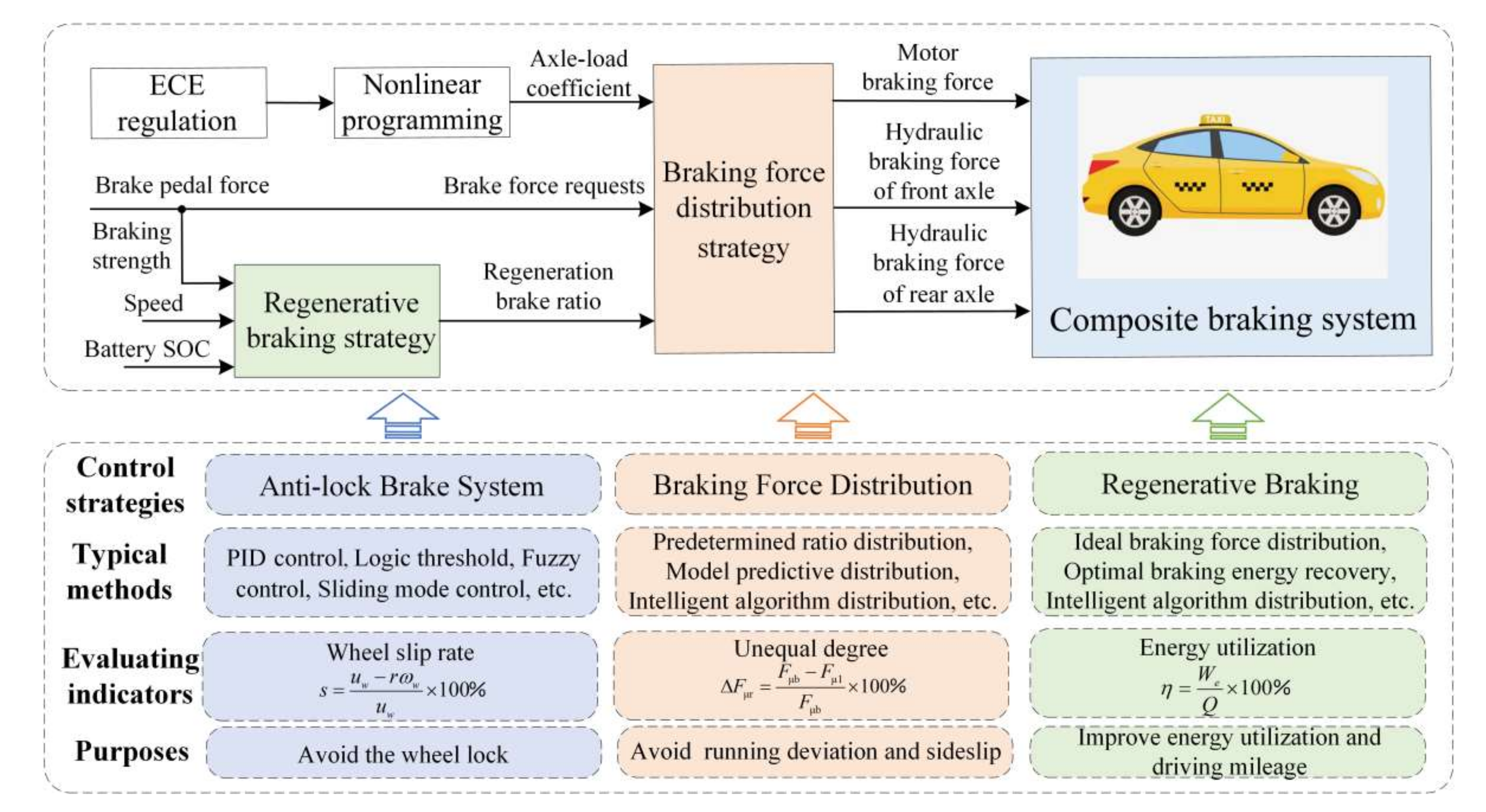
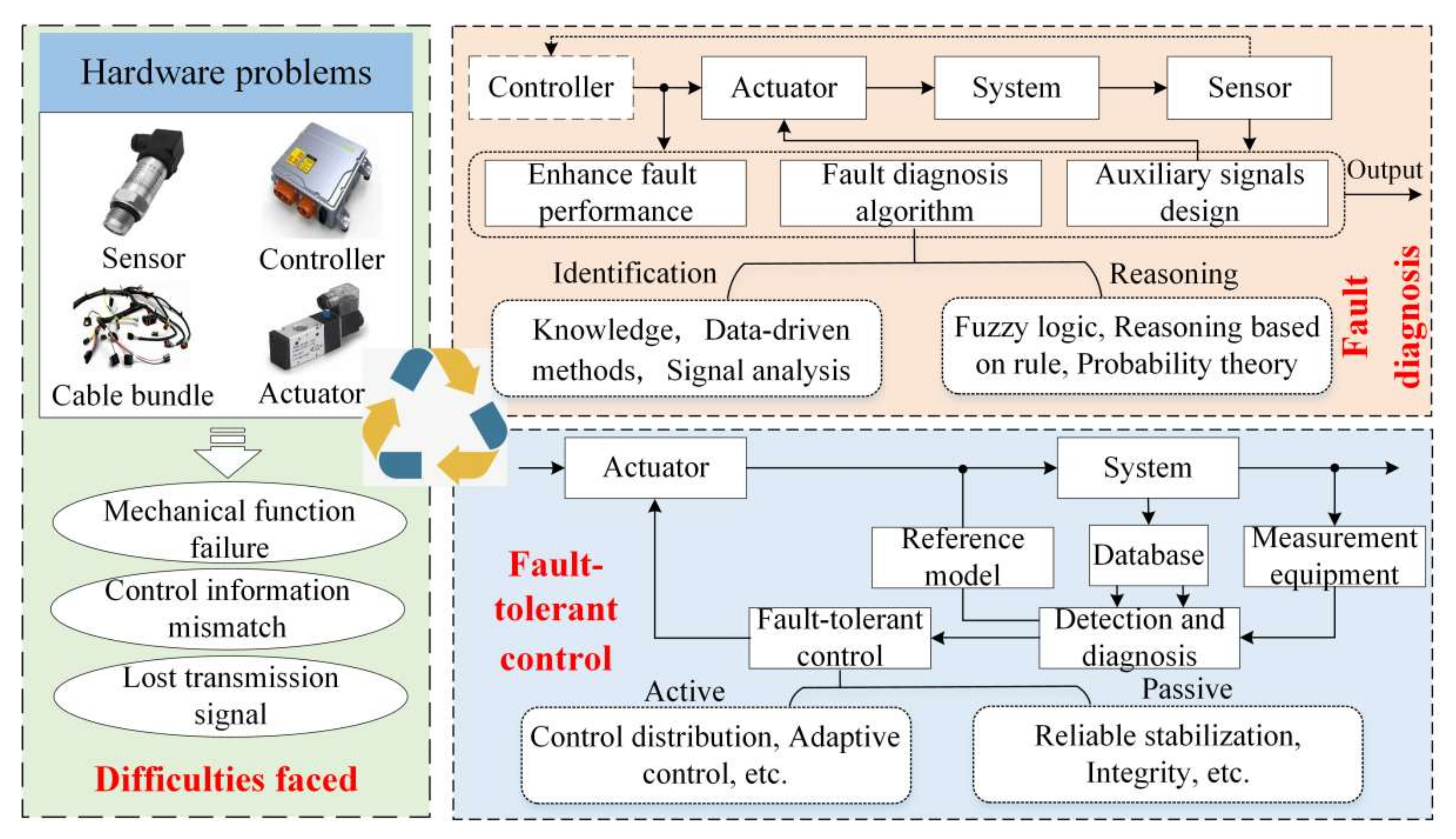
Publisher’s Note: MDPI stays neutral with regard to jurisdictional claims in published maps and institutional affiliations. |
© 2022 by the authors. Licensee MDPI, Basel, Switzerland. This article is an open access article distributed under the terms and conditions of the Creative Commons Attribution (CC BY) license (https://creativecommons.org/licenses/by/4.0/).
Share and Cite
Li, D.; Tan, C.; Ge, W.; Cui, J.; Gu, C.; Chi, X. Review of Brake-by-Wire System and Control Technology. Actuators 2022, 11, 80. https://doi.org/10.3390/act11030080
Li D, Tan C, Ge W, Cui J, Gu C, Chi X. Review of Brake-by-Wire System and Control Technology. Actuators. 2022; 11(3):80. https://doi.org/10.3390/act11030080
Chicago/Turabian StyleLi, Dexiang, Cao Tan, Wenqing Ge, Jin Cui, Chaofan Gu, and Xuwen Chi. 2022. "Review of Brake-by-Wire System and Control Technology" Actuators 11, no. 3: 80. https://doi.org/10.3390/act11030080
APA StyleLi, D., Tan, C., Ge, W., Cui, J., Gu, C., & Chi, X. (2022). Review of Brake-by-Wire System and Control Technology. Actuators, 11(3), 80. https://doi.org/10.3390/act11030080






